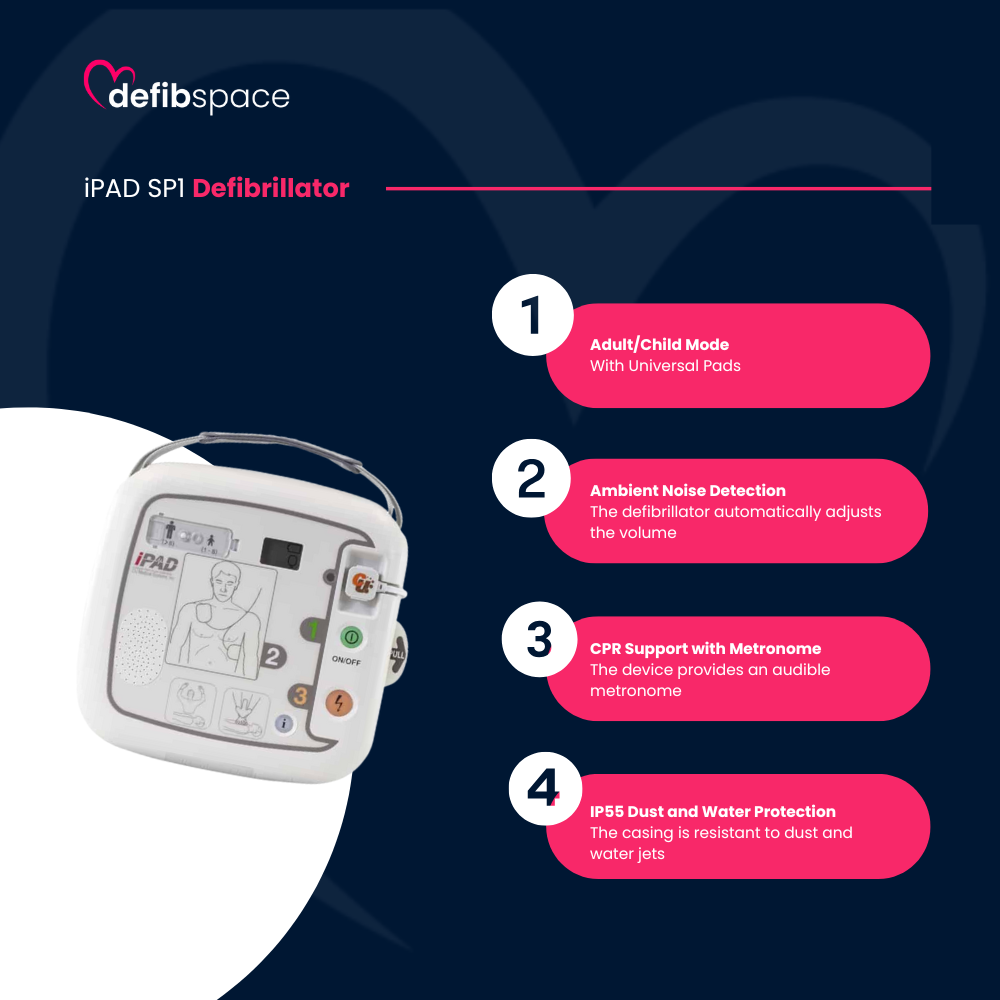Why you should choose the iPAD SP1 Defibrillator
Sudden cardiac arrest (SCA) is one of the leading causes of unexpected death in the UK. When it occurs, the heart stops pumping effectively, and immediate intervention is required. An automated external defibrillator (AED) delivers a controlled electrical shock that can restore a normal heart rhythm.
Public access defibrillators are increasingly common in workplaces, schools, sports centres, and community areas. Their availability improves survival rates significantly when used alongside cardiopulmonary resuscitation (CPR).
The iPAD SP1 defibrillator, produced by CU Medical Systems, is widely used across the UK. It is recognised by ambulance services, charities, and health organisations for its reliability and ease of use in emergencies. This makes it a frequent choice for both community groups and professional settings.
Did You Know?
Survival rates from out-of-hospital cardiac arrest can triple when a defibrillator is used within the first three minutes of collapse. (British Heart Foundation, BHF)
Overview of the iPAD SP1 Defibrillator
The iPAD SP1 is a public access defibrillator manufactured by CU Medical Systems, a company with over two decades of experience in resuscitation technology. It has become one of the most widely deployed defibrillators in the UK, supported by suppliers such as the British Heart Foundation and Wel Medical.
The device is available in both fully automatic and semi-automatic versions:
Fully automatic: the defibrillator analyses the heart rhythm and delivers a shock automatically if needed.
Semi-automatic: the defibrillator advises a shock but requires the user to press a button to deliver it.
This flexibility allows organisations to choose a model that best suits their users’ confidence and training levels.
The iPAD SP1 is also widely adopted by ambulance services and community defibrillator schemes, which highlights its reliability and recognition across the healthcare sector. It is designed to be suitable for both trained first aiders and members of the public with minimal or no medical knowledge.
Key Features of the iPAD SP1
The iPAD SP1 defibrillator includes several design features that make it suitable for a wide range of environments and users.
Adult/Child Mode with Universal Pads
The defibrillator uses a simple switch to change between adult and child treatment. The same set of pre-connected electrode pads can be used for both age groups. This removes the need to buy and store separate paediatric pads, reducing costs and simplifying maintenance.
Ambient Noise Detection
Built-in sensors monitor background noise. If the environment is loud, such as in a busy workplace or public area, the device automatically adjusts its voice prompt volume. This ensures instructions remain clear and easy to follow.
CPR Support
The iPAD SP1 provides a metronome to guide chest compressions at the correct rate. This helps rescuers maintain effective cardiopulmonary resuscitation alongside the use of the defibrillator.
Self-Testing and Readiness Indicators
The defibrillator performs regular self-checks to ensure it is ready for use. Visual indicators show the status of the battery and pads, reducing the risk of discovering faults during an emergency.
IP55 Rating for Dust and Water Resistance
The casing is tested to resist dust and water jets, making the iPAD SP1 durable enough for use in outdoor or challenging environments.
Robust and Reliable Design
The unit is tested for impact resistance and is supplied with a long warranty period, reflecting its build quality and durability.
Benefits of Choosing the iPAD SP1
The iPAD SP1 defibrillator offers several advantages that make it a strong choice for organisations, communities, and workplaces.
Easy to Use for All Confidence Levels
Clear voice prompts, simple controls, and pre-connected pads ensure the defibrillator can be operated quickly by both trained first aiders and members of the public with no prior experience.
Cost-Effective Operation
The universal pads work for both adults and children, so only one set needs to be purchased and replaced when expired. This reduces ongoing costs compared with defibrillators that require separate paediatric pads. The long battery life also helps keep replacement needs infrequent.
Reliability in Emergencies
Regular self-tests and clear readiness indicators provide reassurance that the device is functional at all times. Its rugged design, including IP55 protection, makes it suitable for varied environments, from offices and schools to outdoor community locations.
Recognised by Emergency Services
The iPAD SP1 is widely adopted by UK ambulance services and public defibrillator programmes. This endorsement demonstrates its reliability and ensures compatibility with national resuscitation strategies.
Did You Know?
Some ambulance services recommend the iPAD SP1 specifically for community defibrillator schemes because its adult/child switch makes it safer in locations where children are often present, such as schools and leisure centres (iPAD AED).
Comparison with Alternative Defibrillators
When selecting a public access defibrillator, it is useful to compare the iPAD SP1 with other widely used models.
Pad Compatibility
Many defibrillators require separate paediatric pads for children under eight years. This increases cost and the chance of confusion in an emergency. The iPAD SP1’s universal pads and child switch simplify this process, offering an advantage over models that need additional consumables.
Environmental Protection
Some entry-level defibrillators have a lower IP rating, making them less suited for outdoor or dusty environments. The iPAD SP1, with its IP55 protection, offers stronger resistance against water and dust.
Ease of Use
While most modern defibrillators provide voice prompts, not all feature ambient noise detection. This function makes the iPAD SP1 particularly useful in public or busy locations where instructions could otherwise be drowned out.
Recognition and Support
The iPAD SP1 is officially used by several ambulance services in the UK, which is not always the case for other defibrillator models. This means its design, accessories, and operation are familiar to emergency responders.
Overall, the iPAD SP1 combines a wide feature set with proven reliability. While other defibrillators may offer similar functions, few bring together child compatibility, environmental durability, and user-friendly design in one unit.
Maintenance and Running Costs
Owning a defibrillator requires some ongoing attention to keep it ready for use. The iPAD SP1 is designed to make this process as simple as possible.
Pad and Battery Lifespan
Pads: The universal electrode pads typically last around two to three years before they need replacing, unless they are used in an emergency.
Battery: The battery has a long operational life, often up to five years, depending on usage and storage conditions.
This reduces the frequency of replacements compared with some alternative models, lowering long-term costs.
Automated Self-Checks
The defibrillator carries out regular self-tests, including checks on the battery and pads. Status indicators alert users if maintenance is required, meaning problems can be spotted early without specialist equipment.
Accessories and Cabinets
A range of storage cabinets and carry cases are available. In many public installations, a heated external cabinet is recommended to protect the unit from cold temperatures. These cabinets also help increase visibility, ensuring the defibrillator is easy to locate in an emergency.
Cost Management
Because the same pads can be used for both adults and children, organisations avoid the additional expense of buying separate paediatric consumables. This makes the iPAD SP1 more economical to run over time.
Real-World Use and Observations
The iPAD SP1 defibrillator is widely installed across the UK in both community and workplace settings. It is frequently chosen for schools, leisure centres, offices, and public spaces because of its dual adult/child capability and straightforward operation.
In many rural areas, community groups select the iPAD SP1 for use in outdoor cabinets. Its IP55 protection and robust casing mean it can cope with less controlled environments, such as village greens, car parks, and sports grounds.
Observation:
In practice, the effectiveness of any defibrillator depends not just on its features but also on how accessible it is. Cabinets placed in prominent locations with clear signage are more likely to be used quickly in an emergency. By contrast, units hidden in locked rooms or poorly marked cupboards may go unnoticed when urgently needed.
The iPAD SP1 is also recognised by ambulance services, meaning first responders are familiar with its layout and operation. This consistency can make the transition from bystander use to professional handover smoother.
Did You Know?
The iPAD SP1 defibrillator is the standard model used by the Welsh Ambulance Service, and it is also widely recommended in other regional ambulance trusts. This endorsement reflects confidence in its reliability and ease of use (iPAD AED).
Defibrillators with an IP55 rating, such as the iPAD SP1, are protected against dust and low-pressure water jets. This makes them suitable for outdoor installations, provided they are housed in a secure cabinet.
According to the British Heart Foundation, immediate use of a defibrillator can increase survival rates from sudden cardiac arrest by up to 70%, particularly when combined with effective CPR (BHF).
FAQs
Is the iPAD SP1 available as both semi-automatic and fully automatic?
Yes. Organisations can choose between a semi-automatic version, which requires the rescuer to press a button to deliver the shock, and a fully automatic version, which delivers the shock without further input once advised.
How long do the battery and pads last?
The battery typically lasts up to five years under normal conditions. The universal pads usually last two to three years, unless they are used in an emergency and need replacing sooner.
Can the iPAD SP1 be used on children?
Yes. The defibrillator includes a child switch that adjusts the energy level for patients under eight years old. This means the same set of pads can be used for both adults and children.
What environments is it suitable for?
With an IP55 rating, the iPAD SP1 is resistant to dust and water. It is suitable for offices, schools, sports facilities, and, when placed in a heated cabinet, outdoor community locations.
How does it support CPR?
The defibrillator provides a metronome to guide the rescuer in delivering chest compressions at the correct rate, helping to improve the effectiveness of CPR.
Conclusion
The iPAD SP1 defibrillator combines user-friendly design with robust technical features, making it suitable for both professional and public settings. Its universal pads, child mode switch, and clear voice guidance reduce complexity in emergencies, while self-testing and durability ensure it remains reliable when needed most.
By being widely recognised by UK ambulance services and trusted in community defibrillator schemes, the iPAD SP1 has established itself as one of the most practical and dependable choices available. For organisations, schools, workplaces, and public installations, it offers a balance of ease of use, cost efficiency, and proven reliability.
Sources
British Heart Foundation (BHF) – Defibrillator Support and Guidance
https://www.bhf.org.uk/informationsupport/support/practical-support/defibrillators
Provided statistics on survival rates and general information on public access defibrillators.iPAD AED – Emergency Services Adoption
https://www.ipad-aed.com/emergency-services/
Confirmed that the iPAD SP1 is used and recommended by UK ambulance services.Wel Medical – Product Information
https://shop.welmedical.com/product/ipad-sp1-semi-automatic-defibrillator/
Provided details on models available (semi-automatic vs fully automatic), accessories, and consumable lifespans.Medisol International – Technical Features
https://www.medisolinternational.com/cu-medical-i-pad-sp1-fully-automatic-defibrillator.html
Source for specific technical features including ambient noise detection, metronome, and IP55 protection.BHF Defibrillator Packages
https://defibrillators.bhf.org.uk/ipad-sp1-fully-automatic-defibrillator-and-unlocked-internal-cabinet-package
Supported details on environmental protection, self-tests, and maintenance requirements.



